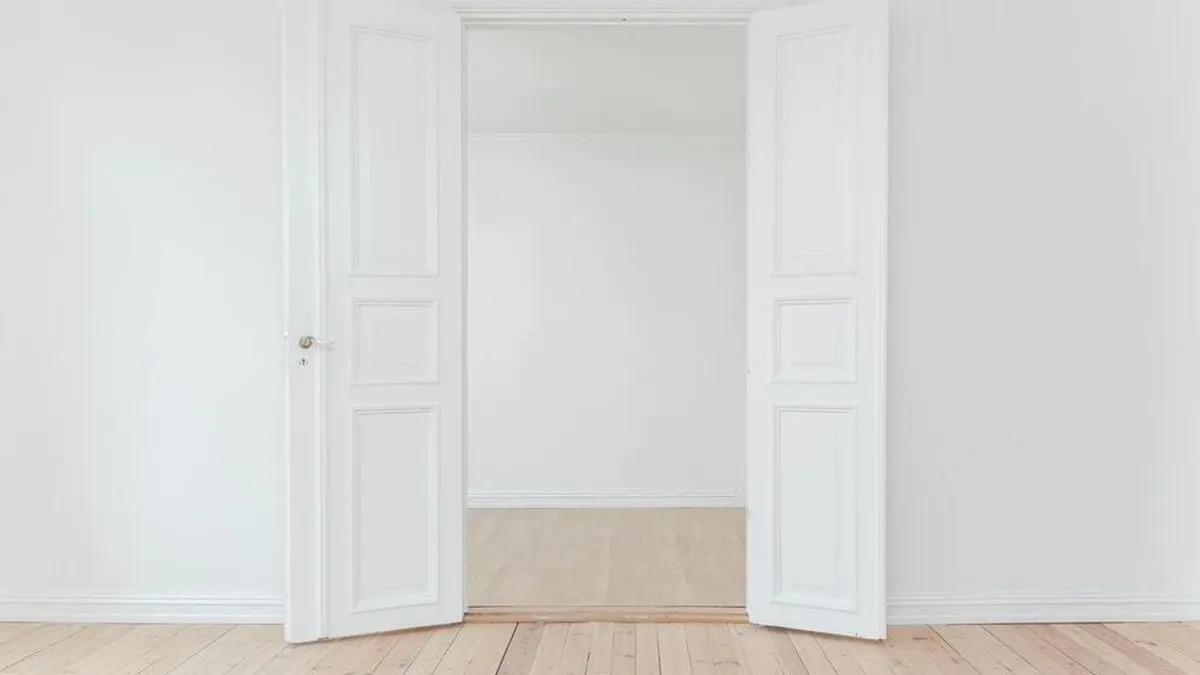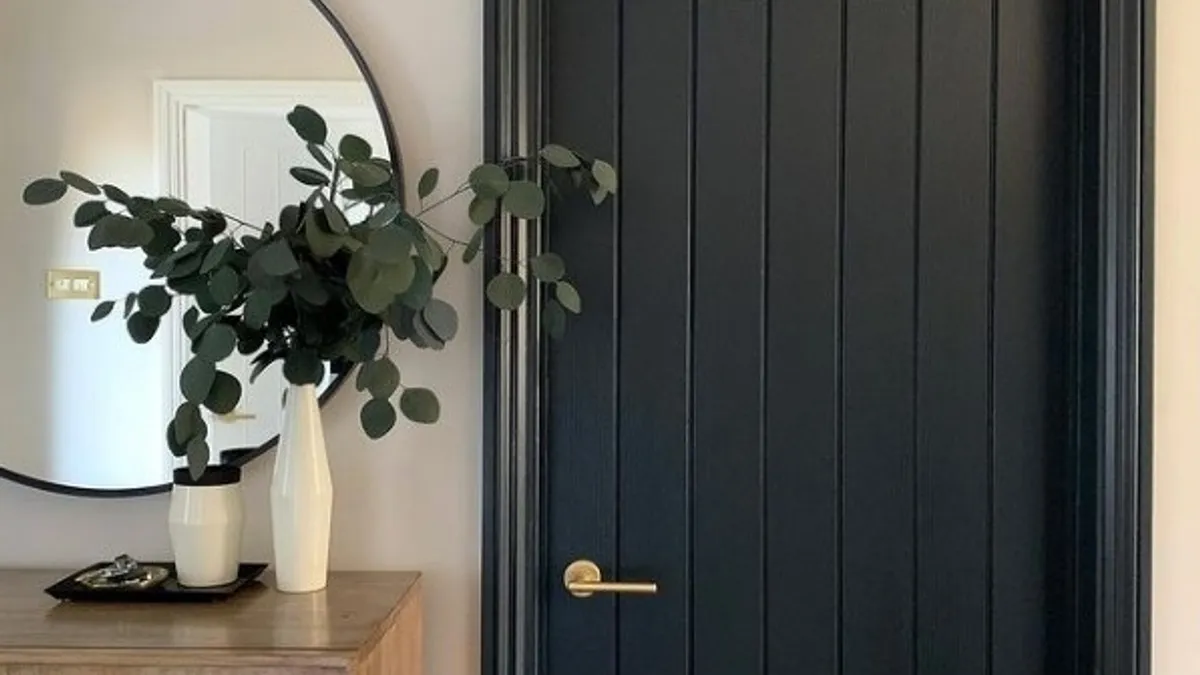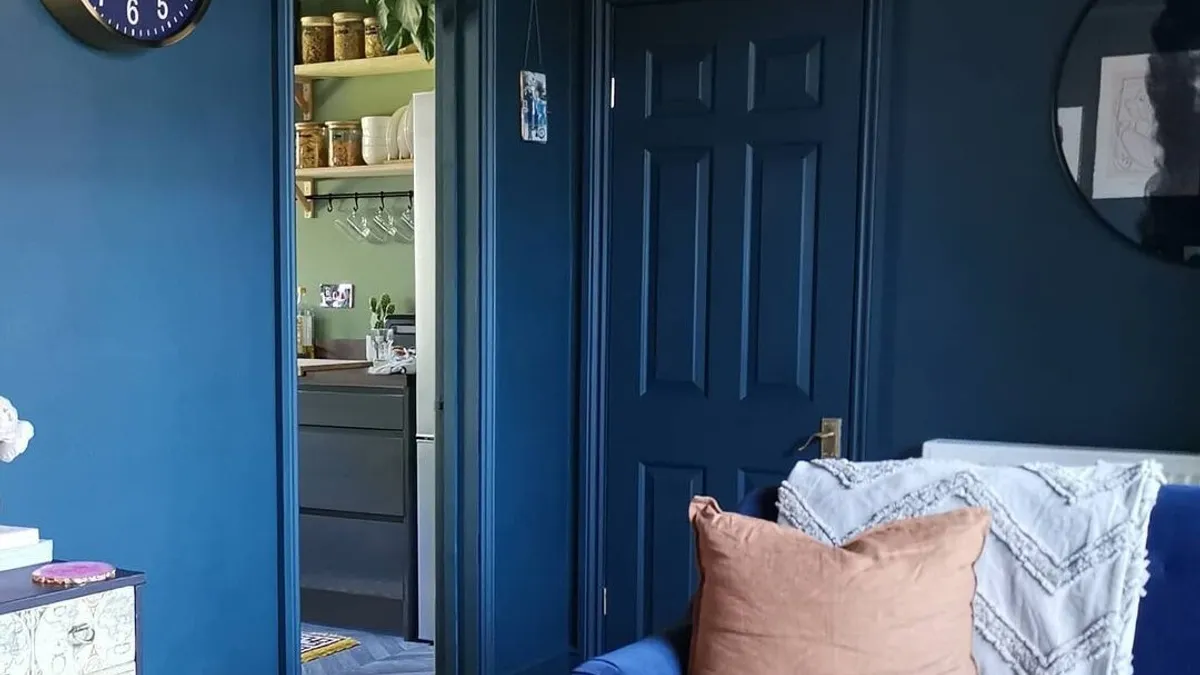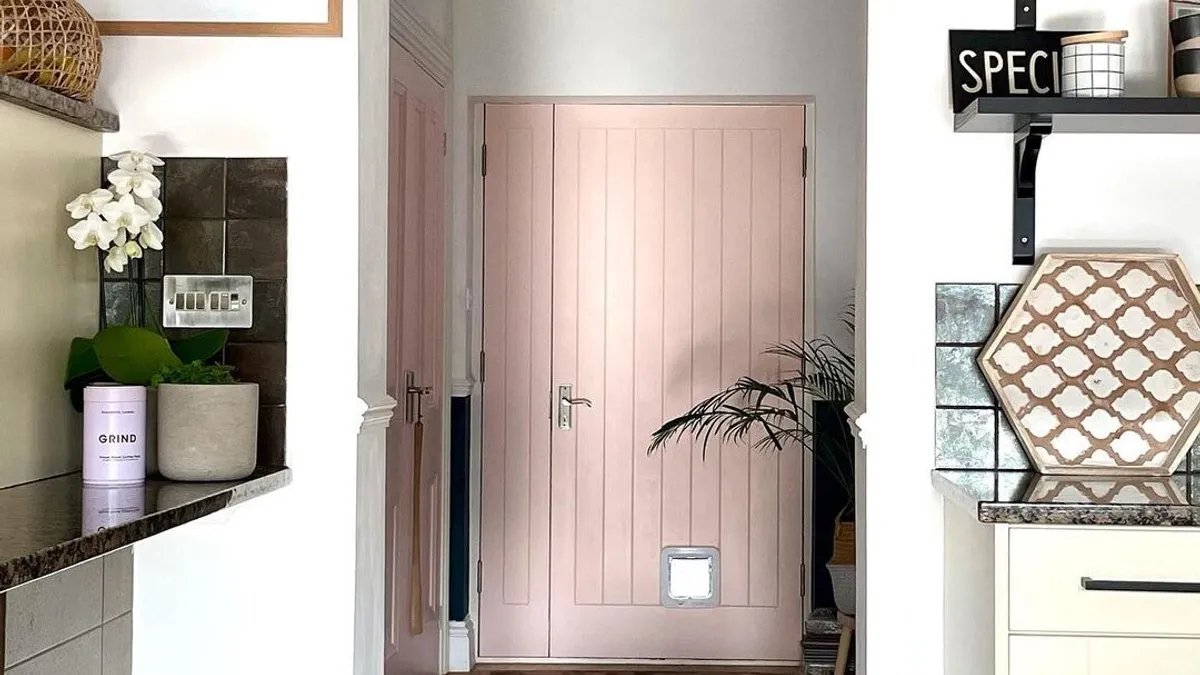The Best Interior Door Paints
Wondering what the best interior door paint is? Trying to find out what the best paint for any decorating project can be difficult, which is why our experts, who have other 30 years experience in the decorating trade, have put together this guide to the best paints for interior doors, so you can discover the paint for you.

What Is Interior Door Paint?
First, let's talk about what is actually meant by an interior door paint. Interior doors are made of various timber materials, from softwood to hardwood. Although there is no specific interior door paint, there are a range of paints that are designed to be applied to interior wooden surfaces, such as doors, skirting boards and furniture.
When discussing paints, it is crucial to distinguish the difference between them. As you may well know, paints come in a range of finishes that vary in 'sheen', otherwise known as the amount of light they reflect. The other key difference between these finishes other than the light they reflect is the durability. The higher the sheen, the more durability the paint has.
Here are the main paint finishes you find in the UK:
- Matt - the lowest sheen finish of paint that is completely flat. It is the most popular finish for interior walls & ceilings, while its low durability means it is not the best choice for other surfaces, especially in the standard vinyl matt emulsions.
- Eggshell - eggshell is perfect if you want a slightly higher sheen than matt and require slightly more durability. It is used on interior walls & ceilings in water-based form, as well as on wood & metal in water-based and oil-based form.
- Satin - a mid-sheen finish that is designed for use on woodwork & metal surfaces.
- Silk - a mid-sheen finish that is generally designed for use on interior walls & ceilings.
- Soft Sheen - a mid-sheen finish with a slightly subtle look compared to silk, for interior walls & ceilings.
- Gloss - the highest sheen of paint, most commonly used on woodwork & metal.
When it comes to interior doors & other woodwork, the choice is between an eggshell, satin or gloss finish, depending on the level of durability and the finish you desire. Eggshell as the flattest finish can provide a beautifully modern look, while gloss provides the most durability against scratches and knocks.
As we have eluded to, aside from the finish, paints also come in two broad forms; oil-based formulations and water-based formulations. These vary on the form of solvent that is used to dry the paint, with oil-based paints using a solvent and water-based paints using water.
Here are the key advantages & disadvantages of both types of paint:
Water Based Paint Advantages
- Quick drying - meaning they can be reapplied within one day
- Brushes can be cleaned with water
- Low odour
- Do not yellow
- Lower VOC's
Water Based Paint Disadvantages
- Can be more prone to chipping
- Take as long as two weeks to fully harden
- Less impressive sheen and finish
Oil Based Paint Advantages
- Higher sheen
- Can be easier to achieve a professional finish
- Offer more durability
- Harden quicker
Oil Based Paint Disadvantages
- Comes with an odour that can be unpleasant
- Brushes must be cleaned using white spirit
- Higher VOC's
- They yellow over time, especially with white shades
Generally, we would recommend that if you are a DIY'er, use a water-based paint that is easier to use and clean up. While oil-based paint traditionally has been of a higher quality, advances in recent years in water-based technology and new regulations relating to the VOC's in oil-based paint has meant that both formulations are equally high-quality. Having said this, it is down to personal preference, which is why our list of the best interior door paints contains both water and oil-based paints.
What Is The Best Interior Door Paint?
All of the paints on our list of the best interior door paints are examples of trade paints. You may be wondering, what is a trade paint? All major paint manufacturers have two versions of their paints; a trade paint and a retail paint. The trade paint is higher quality, has better durability, leaves a nicer finish and has a higher coverage, while the retail paint is poorer quality, and thus comes with a smaller price tag. While trade paint is more expensive, the reality is that due to the higher coverage and the better durability, trade paint actually offers much better value for money than retail paints. While you can save upfront by opting for a cheap paint, this can mean you will have to repaint the surface in a matter of years when the paint fails.
The reason why people want to find the best interior door paint is that they want a paint that will look beautiful once applied and will remain that way long-term. By spending slightly more upfront, you will save yourself money and time down the line, trust us! Don't worry, trade paint is just as easy to buy and apply, so you don't have to be a painter and decorator to use it.
1. Dulux Diamond Satinwood
At the top of the pile when it comes to paint for interior doors is Diamond Satinwood from Dulux Trade which is a water-based paint that comes in a satin finish. It has all of the benefits that come with a water-based paint, including the ability to apply more than one coat in a day thanks to it being quick-drying. Furthermore, it has exceptional durability thanks to Dulux's 'Diamond' technology, meaning won't scuff or mark easily, which can be a problem with other water-based paints.
Aside from its performance, it can be mixed in any colour you want with the paint mixing service here at Painters World. On our paint mixing machines, we can mix Dulux Diamond Satinwood in any RAL, British Standard or equivalent shades of all major manufacturers, even designer shades. We do not list all of the colours we can mix, which is why you can simply type in the name of the shade you are looking for in our text box and we will mix an equivalent shade.
Overall, it represents the best quality water-based paint you can find in the UK, plus it is extremely easy to use for DIY'ers. Due to its quality, it has a price tag to match. It is one of the most expensive products on the market, however you really do get what you pay for. If want a paint that will perform to the highest standards and want to achieve a traditional satin finish, Dulux Diamond Satinwood is the best option for you.
Pros:
- Water-based - quick drying, non-yellowing & low VOC's
- High quality, professional finish
- Can be mixed in any colour
- Excellent durability
- Self-undercoating
Cons:
- Is one of the more expensive paints on the market
- 12m2 coverage per litre, which is slightly lower than alternatives
2. Tikkurila Helmi
Tikkurila is a brand that is synonymous with premium quality paint. Tikkurila Helmi is the brand's water-based acrylic paint designed for interior wooden surfaces & trim, such as doors, skirting boards and furniture. It offers a superb coverage and a professional finish on any interior woodwork, with leading levels of application and opacity. It is available in thousands of colours, as it is available in our paint mixing service.
The other benefit of Helmi aside from its performance is its versatility. It is available in matt, satin & gloss finishes, allowing you to choose what level of sheen you want for your interior doors. Tikkurila do things a little differently than other paint brands. They do not label their products matt, satin or gloss, instead using numbers in their product names to describe the sheen level. The lower the number, the lower the sheen, meaning their Helmi 10 is a matt finish, Helmi 30 is a satin finish & Helmi 80 is a gloss finish.
Pros:
- Excellent opacity
- Can be mixed in any colour
- Available in matt. satin & gloss
- Low VOC
Cons:
- Is slightly more expensive than other options
3. Crown Trade Fast Flow QD Eggshell
If you are looking for a water-based eggshell finish, which is an increasingly popular form of paint for interior wooden surfaces, we would recommend Crown Trade Fast Flow QD Eggshell White. Unlike some water-based eggshells that are designed for interior walls or interior woodwork, this is specifically designed for woodwork in mind!
An eggshell finish offers the lowest sheen level that is ideal for use on interior doors, as an acrylic matt will often not have the required durability for the knocks doors can take. The sheen of an eggshell finish is ideal if you want a modern, low sheen finish that works perfectly with flat matt interior walls & ceilings.
As a water-based formulation, you benefit from non-yellowing, quick drying time & low odour, plus an excellent opacity & a high-quality finish that you usually only achieve with a solvent based finish.
Pros:
- 15m2 per litre coverage
- Great value for money
- Achieves a low sheen, modern finish
- Quick drying
- 99% solvent free
- Great opacity
Cons:
- Has less durability than satin and gloss finishes
4. Dulux Trade Eggshell
When looking for an oil-based eggshell paint, you are looking for durability, the ability for it to not yellow in the short-term and a professional finish. Dulux Trade Eggshell is a paint that ticks all of these boxes, which is why we'd highly recommend it as a fantastic oil-based eggshell.
It has an excellent coverage of up to 17m2 per litre, does not yellow when used in white as quickly as most other oil-based paints and is self-undercoating when applied to previously painted surfaces. As an oil-based paint, it also dries harder than the water-based eggshells, which is ideal if you are using it on an interior door that will take a large amount of wear and tear.
While oil-based paints can yellow over time, as we have mentioned, when used in a colour this can be a fantastic option.
Pros:
- Achieves a low sheen, modern finish
- Can be mixed in any colour
- Exceptional coverage of 17m2 per litre
- Self-undercoating
- Hardwearing
- Less prone to yellowing compared to other oil-based paints
Cons:
- Has less durability than satin and gloss finishes
- Is more expensive than alternatives
5. Armstead Trade Satin
The final recommendation from our experts is Armstead Satin, which is a fantastic oil-based satin paint that is extremely good value for money, being from the budget brand from AkzoNobel, who also manufacturer Dulux paints.
It represents one of the cheapest trade paints that can be applied on interior doors, while still providing a hardwearing and professional finish. If you are on a budget and need a good quality satin paint from a reputable trade brand, this is perfect for you!
Pros:
- Superb value for money
- Can be mixed in any colour
- Exceptional coverage of 17m2 per litre
- Self-undercoating
- Hardwearing
- Achieves a professional finish
Cons:
- Will yellow over time
How To Paint Interior Doors
Once you have the interior door paint that is best suited for you, it is time to get painting.
What You Will Need:
- Paint
- Primer (if required)
- Paint brush
- Mini-roller
- Various grit sandpaper
- Dust sheet
- Masking tape
- Tack cloth
Step 1 - Preparation
Before you pick up any paint brushes, you must ensure the interior door is ready to be painted. Do not skip this step and this is the key to achieving long-lasting results.
Begin by cleaning the door using a general cleaner & degreaser or some hot soapy water as any dirt or grease will impact the ability for the paint to adhere to the door. After this, give the door a light sand down using a medium grit sandpaper. This removes any imperfections and creates a light 'key' for the paint to adhere to. Make sure you wipe down the door with a tack cloth once you have sanded to remove any dust.
Once the surface is clean and sanded, you can then put down a dust sheet on the floor to prevent spillages and apply masking tape to the edges and to the hinges. We recommend you use a good quality masking tape as this is the secret to achieving those razor-sharp lines. A poor quality masking tape will allow the paint to bleed through the tape.
Some people choose to remove the door handles for the neatest possible finish or even take the door off to paint. You can simply prop the door open halfway if you do not want to remove the door however.
Step 2 - Priming
As we have mentioned in our list of the best interior door paints, some paints do not require a primer. Furthermore, if the door has been previously painted, you do not need to use a primer or undercoat before painting.
In the eventuality that your interior door has been painted using an oil-based paint and you are painting over this in water-based paint, you should use a primer to ensure the best performance possible. If you are unsure whether the door has been painted using oil-based paint, don't worry as there are a number of indicators. Firstly, if the paint has yellowed previously, this is a big sign that an oil-based paint was used. Alternatively, if you put some alcohol on a cloth and wipe the paintwork you will be able to identify whether it is oil-based paint or not. Oil-based paint will not come off, so if the paint comes off, you know its water-based.
The chances are, your door has already been painted, although if it is a bare wood door that you are painting, you should always apply a primer.
A primer is a one-coat system that will help to create a base coat ready to be painted. It is a thin consistency, which makes it very easy to apply a thin priming layer using a paint brush or roller to the woodwork. Be careful not to drip the primer onto other surfaces as once dry it is difficult to get off.
Step 3 - Painting
Once your door is clean, sanded & primed if required, it is time to get painting. If you are using a water-based paint, you must use a synthetic paint brush. This is because natural bristle brushes will absorb water, which is why they are reserved for use with oil-based paints. We highly recommend the Hamilton Prestige 5 Piece Synthetic Brush Set if you want a number of high-quality synthetic brushes that will last you years. You may also choose to use a mini-roller, which will get you a perfectly smooth finish on the woodwork without any brush marks. Something like the Wooster Jumbo-Koter Red Feather 4.5" Mini-Roller Sleeve 2 Pack is perfect for painting woodwork.
Start at the top, slowly work around the edges of the door with your first coat of paint. Once you have painted the edges, you can then use your mini-roller to paint each panel of the door. You will find that the roller will find it difficult to paint within any mouldings, which is why a paint brush is a must.
When your first coat is finished and completely dry, it is recommended that you give this a light sand using a fine sandpaper, such as a 320-grit sandpaper. This is optional but helps to create a beautifully high sheen finish on your doors. Ensure you remove the sand using a tack cloth before applying your second coat.
You can then repeat the process with your second coat of paint. If you are using a good quality paint this will be your final coat, so ensure you achieve a smooth, even finish. Once finished, leave to dry completely before removing any masking tape and reattaching your handles.
Frequently Asked Questions
Q. How much paint will I need to paint interior doors?
Estimating the amount of paint you will need can be difficult, after all we don't want to waste money in the bottom of a tin. You need to know three things to work this out; the coverage of the paint, the number of coats required and the area of the surface you are painting.
The coverage and number of coats can be easily found on the manufacturers information of the paint you opt for. You can expect around 12m2 coverage per litre from a good quality trade paint, which will almost always cover well in two coats. This means that you will get 6m2 per litre, with two coats required.
The average door in the UK is 1.5 m2, which when painted front and back gives you an area of 3m2. This means that you will need 2L of paint based off these estimations, but this will depend on the paint you use.
It is always better to overestimate paint as you don't want to be left short, plus it is always recommended to have some paint left over for remedial work.
Q. Can you paint interior doors different colours?
Absolutely! The majority of the paints are our list can be mixed in any colour, so you are not limited to just white.
Q. Can you paint interior doors without sanding?
Sanding is part of the recommended preparation process, however it is not essential. It simply allows you to get the smoothest possible finish and helps to create a key for the paint to adhere to, which improves the durability of the paint and makes it easier to apply.
Ideas For Painting Interior Doors
When starting a DIY project, sometimes we just need a bit of inspiration to get our creative juices flowing. When it comes to interior doors, the vast majority are painted white, which while clean & traditional can be slightly boring. Here are a few examples of ways you can paint interior doors to make them stand out from the rest!
1. Grey
Grey can have a reputation for being boring, but we couldn't disagree more. Grey is one of the most versatile colours with so many shades to choose from. Whether you want a subtle light grey like stone grey or a darker grey such as the hugely popular anthracite grey, you can achieve any look you want.

2. Match!
Matching your interior doors to the walls & skirting boards is a less traditional use of colour, but one that is extremely on-trend at the moment. It brings a contemporary twist to a room that is a short cut to completely modernising your home. Whether you opt for colourful, light or dark shades, it can work wonders!

3. Colour
Want to add colour to a space but don't want to go too far with it? Instead of using the colour on interior walls, why not integrate it into the woodwork and detailing of a room? This also works brilliantly when you add colour to a ceiling instead of the walls.
This is especially effective with neutral walls such as whites or creams, which create the perfect canvas to add pops of colour to your decor. It is so effective and a brilliant way to add your favourite colour to your house in a subtle way.

We hope this has answered any questions you may have had regarding the best interior door paints available in the UK today. If you require any more help, just send an email to hello@paintersworld.co.uk and our expert team will be on hand to give you any advice you require. At Painters World we have a wide range of paints available, so no matter the job, we've got the right tools for you.



Sign up now and be the first to know about exclusive offers, product updates, and announcements.










